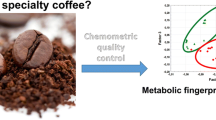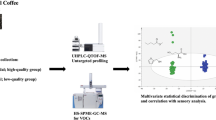Abstract
In coffee manufacture, analytical methods with high-throughput and cost efficacy are required for process development and quality control. Thus, we investigated the applicability of direct mass spectrometry methods to distinguish coffee products according to species, geographic origin and processing. We tested the performance of the established method direct-injection electrospray mass spectrometry (DIESI-MS) and the emerging method low-temperature plasma ionization mass spectrometry (LTP-MS). Both methods are capable of classifying coffee products, but DIESI-MS and LTP-MS yield complementary information about the chemical composition of the samples. DIESI-MS shows a broad molecular weight range of compounds. In contrast, LTP-MS detects mainly low molecular weight compounds, which correspond to quality-related ingredients, such as caffeine and purines. LTP-MS displays a high potential for rapid quality control measurements and online monitoring, because no sample processing is required. Data mining methods support the discovery of ‘important’ compounds, which are responsible for the discrimination between sample groups, and reveal associated chemical processes.

ᅟ




Similar content being viewed by others
References
Alonso-Salces RM, Serra F, Reniero F, Ká H (2009) Botanical and geographical characterization of green coffee (Coffea arabica and Coffea canephora): chemometric evaluation of phenolic and methylxanthine contents. J Agric Food Chem 57:4224–4235. doi:10.1021/jf8037117
Amorim ACL, Hovell AMC, Pinto AC et al (2009) Green and roasted arabica coffees differentiated by ripeness, process and cup quality via electrospray ionization mass spectrometry fingerprinting. J Braz Chem Soc 20:313–321. doi:10.1590/S0103-50532009000200017
Baggenstoss J, Thomann D, Perren R, Escher F (2010) Aroma recovery from roasted coffee by wet grinding. J Food Sci 75:C697–C702. doi:10.1111/j.1750-3841.2010.01822.x
Buffo RA, Cardelli-Freire C (2004) Coffee flavour: an overview. Flavour Fragr J 19:99–104. doi:10.1002/ffj.1325
Choi M-Y, Choi W, Park JH et al (2010) Determination of coffee origins by integrated metabolomic approach of combining multiple analytical data. Food Chem 121:1260–1268. doi:10.1016/j.foodchem.2010.01.035
Eakin H, Winkels A, Sendzimir J (2009) Nested vulnerability: exploring cross-scale linkages and vulnerability teleconnections in Mexican and Vietnamese coffee systems. Environ Sci Pol 12:398–412
FAOSTAT (2013) http://faostat.fao.org/
Farah A (2012) Coffee constituents. In: Chu Y-F (ed) Coffee. Wiley, Hoboken, pp. 21–58
Farah A, de Paulis T, Trugo LC, Martin PR (2005) Effect of roasting on the formation of chlorogenic acid lactones in coffee. J Agric Food Chem 53:1505–1513. doi:10.1021/jf048701t
Flament I, Bessière-Thomas Y (2002) Coffee flavor chemistry. Wiley, Chichester; New York
Freiberger EB, Kaufmann KC, Bona E et al (2015) Encapsulation of roasted coffee oil in biocompatible nanoparticles. LWT-Food Sci Technol 64:381–389. doi:10.1016/j.lwt.2015.05.039
García-Flores M, Juárez-Colunga S, García-Casarrubias A et al (2015) Metabolic profiling of plant extracts using direct-injection electrospray ionization mass spectrometry allows for high-throughput phenotypic characterization according to genetic and environmental effects. J Agric Food Chem 63:1042–1052. doi:10.1021/jf504853w
García-Flores M, Juárez-Colunga S, Montero-Vargas JM et al (2012) Evaluating the physiological state of maize (Zea mays L.) plants by direct-injection electrospray mass spectrometry (DIESI-MS). Mol BioSyst 8:1658–1660. doi:10.1039/c2mb25056j
Garrett R, Vaz BG, Hovell AMC et al (2012) Arabica and Robusta coffees: identification of major polar compounds and quantification of blends by direct-infusion electrospray ionization–mass spectrometry. J Agric Food Chem 60:4253–4258. doi:10.1021/jf300388m
Gonzalez-Rios O, Suarez-Quiroz ML, Boulanger R et al (2007) Impact of “ecological” post-harvest processing on coffee aroma: II. Roasted coffee. J Food Compos Anal 20:297–307. doi:10.1016/j.jfca.2006.12.004
Harper JD, Charipar NA, Mulligan CC et al (2008) Low-temperature plasma probe for ambient desorption ionization. Anal Chem 80:9097–9104
Jeszka-Skowron M, Zgoła-Grześkowiak A, Grześkowiak T (2014) Analytical methods applied for the characterization and the determination of bioactive compounds in coffee. Eur Food Res Technol 240:19–31. doi:10.1007/s00217-014-2356-z
Jha S, Bacon CM, Philpott SM, et al (2011) A review of ecosystem services, farmer livelihoods, and value chains in shade coffee agroecosystems. In: Integrating agriculture, conservation and ecotourism: examples from the field. Springer, pp 141–208
Lewin B, Giovannucci D, Varangis P (2004) Coffee markets: new paradigms in global supply and demand.
Martínez Jarquín S, Winkler R (2016) Non-thermal plasma jet device as source of spatial ionization for ambient mass spectrometry and method of application. United States Patent 9362100
Martínez-Jarquín S, Moreno-Pedraza A, Guillén-Alonso H, Winkler R (2016) Template for 3D printing a low-temperature plasma probe. Anal Chem. doi:10.1021/acs.analchem.6b01019
Martínez-Jarquín S, Winkler R (2013) Design of a low-temperature plasma (LTP) probe with adjustable output temperature and variable beam diameter for the direct detection of organic molecules. Rapid Commun Mass Spectrom 27:629–634. doi:10.1002/rcm.6494
Martín MJ, Pablos F, González AG (1998) Discrimination between arabica and robusta green coffee varieties according to their chemical composition. Talanta 46:1259–1264. doi:10.1016/S0039-9140(97)00409-8
Martín MJ, Pablos F, González AG et al (2001) Fatty acid profiles as discriminant parameters for coffee varieties differentiation. Talanta 54:291–297. doi:10.1016/S0039-9140(00)00647-0
Mendonça JCF, Franca AS, Oliveira LS, Nunes M (2008) Chemical characterisation of non-defective and defective green arabica and robusta coffees by electrospray ionization-mass spectrometry (ESI-MS). Food Chem 111:490–497. doi:10.1016/j.foodchem.2008.03.080
Montero-Vargas JM, González-González LH, Gálvez-Ponce E et al (2013) Metabolic phenotyping for the classification of coffee trees and the exploration of selection markers. Mol BioSyst 9:693–699. doi:10.1039/C3MB25509C
Moreno FL, Quintanilla-Carvajal MX, Sotelo LI et al (2015) Volatile compounds, sensory quality and ice morphology in falling-film and block freeze concentration of coffee extract. J Food Eng 166:64–71. doi:10.1016/j.jfoodeng.2015.05.018
Nascimento EA, Morais SA, Chang R, et al (2015) Looking for unknown molecules in Arabica and Robusta coffee brews by high performance liquid chromatography coupled to high resolution mass spectrometry and differentiating both coffee species by this technique.
Oestreich-Janzen S (2010) Chemistry of coffee In: Comprehensive natural products II: Chemistry and Biology: 10 Volume Set. In: Mander L, Liu H-W (eds). Elsevier Science
Padma Ishwarya S, Anandharamakrishnan C (2015) Spray-freeze-drying approach for soluble coffee processing and its effect on quality characteristics. J Food Eng 149:171–180. doi:10.1016/j.jfoodeng.2014.10.011
Parras P, Martínez-Tomé M, Jiménez AM, Murcia MA (2007) Antioxidant capacity of coffees of several origins brewed following three different procedures. Food Chem 102:582–592
Pizarro C, Esteban-Díez I, González-Sáiz JM (2007) Mixture resolution according to the percentage of robusta variety in order to detect adulteration in roasted coffee by near infrared spectroscopy. Anal Chim Acta 585:266–276. doi:10.1016/j.aca.2006.12.057
Ponte S (2002) The latte revolution’? Regulation, markets and consumption in the global coffee chain. World Dev 30:1099–1122
Rakesh Jaiswal MFM (2014) Does roasted coffee contain chlorogenic acid lactones or/and cinnamoylshikimate esters? Food Res Int 61:214–227. doi:10.1016/j.foodres.2013.09.040
Rogers WJ, Michaux S, Bastin M, Bucheli P (1999) Changes to the content of sugars, sugar alcohols, myo-inositol, carboxylic acids and inorganic anions in developing grains from different varieties of Robusta (Coffea canephora) and Arabica (C. arabica) coffees. Plant Sci 149:115–123. doi:10.1016/S0168-9452(99)00147-8
Romano R, Santini A, Le Grottaglie L et al (2014) Identification markers based on fatty acid composition to differentiate between roasted Arabica and Canephora (Robusta) coffee varieties in mixtures. J Food Compos Anal 35:1–9. doi:10.1016/j.jfca.2014.04.001
Sturm M, Bertsch A, Gröpl C et al (2008) OpenMS—an open-source software framework for mass spectrometry. BMC Bioinformatics 9:163. doi:10.1186/1471-2105-9-163
Tarzia A, Dos Santos Scholz MB, De Oliveira Petkowicz CL (2010) Influence of the postharvest processing method on polysaccharides and coffee beverages. Int J Food Sci Technol 45:2167–2175. doi:10.1111/j.1365-2621.2010.02388.x
Wei F, Furihata K, Koda M et al (2012) 13C NMR-based metabolomics for the classification of green coffee beans according to variety and origin. J Agric Food Chem 60:10118–10125. doi:10.1021/jf3033057
Weschenfelder TA, Lantin P, Viegas MC et al (2015) Concentration of aroma compounds from an industrial solution of soluble coffee by pervaporation process. J Food Eng 159:57–65. doi:10.1016/j.jfoodeng.2015.03.018
Williams G (2011) Data mining with rattle and R. Springer New York, New York, NY
Winkler R (2015a) SpiderMass: semantic database creation and tripartite metabolite identification strategy. J Mass Spectrom 50:538–541. doi:10.1002/jms.3559
Winkler R (2015b) An evolving computational platform for biological mass spectrometry: workflows, statistics and data mining with MASSyPup64. Peer J 3:e1401. doi:10.7717/peerj.1401
Author information
Authors and Affiliations
Corresponding author
Ethics declarations
Funding
This study was funded by Secretaría de Agricultura, Ganadería, Desarrollo Rural, Pesca y Alimentación (SAGARPA) and the Consejo Nacional de Ciencia y Tecnología (CONACyT), Mexico, with grants AVANCE N° 127280, INNOVATEC PEI 451/2012, FIT S0017-2015-01, I0017/CB2010-01/151596, FINNOVA I010/260/2014 and FRONTERAS 2015-2/814. RGB, JMMV, SMJ and AMP thank CONACYT for their postgraduate fellowships.
Conflict of Interest
SMJ and RW are inventors of the patent application ‘Non-thermal plasma jet device as source of spatial ionization for ambient mass spectrometry and method of application’ (WO 2014/057409, United States Patent 9362100). The micromass ZQ was borrowed from Waters, Mexico. Agroindustrias Unidas de Mexico SA de CV and Garcomex SA de CV provided samples. The sponsors were not involved in the study design, collection, analysis or interpretation of data.
Informed Consent
Not applicable.
Rights and permissions
About this article
Cite this article
Gamboa-Becerra, R., Montero-Vargas, J.M., Martínez-Jarquín, S. et al. Rapid Classification of Coffee Products by Data Mining Models from Direct Electrospray and Plasma-Based Mass Spectrometry Analyses. Food Anal. Methods 10, 1359–1368 (2017). https://doi.org/10.1007/s12161-016-0696-y
Received:
Accepted:
Published:
Issue Date:
DOI: https://doi.org/10.1007/s12161-016-0696-y




